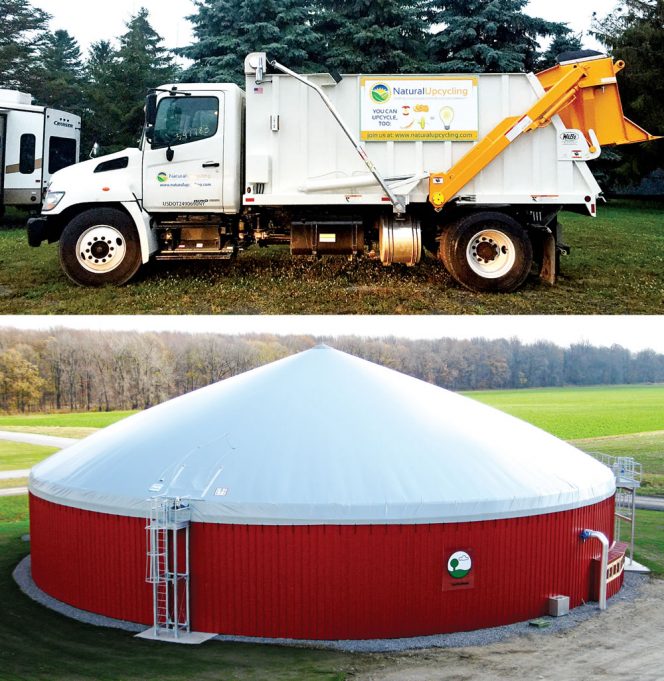Natural Upcycling Services collects commercial food waste in western New York, diverting most of it to anaerobic digesters.
Katrina Mendrey
BioCycle May 2017
Chris Noble is part of a family business enterprise that includes Noblehurst Farms, which operates an anaerobic digester (AD), Noblehurst Green Energy, as part of their dairy business located in Livingston County, New York. Three years ago, Noble and food waste hauler Harry Cohen, saw the opportunity to partner together and provide a suite of food waste management services, including hauling, depackaging, recycling, composting and anaerobic digestion, to customers in New York State.
Their company, Natural Upcycling Services, started with a tote-based collection service in the Rochester, New York area, hauling preconsumer food scraps from restaurants, grocers, food distribution centers and universities in 32- or 64-gallon totes. Using an onboard power washing system, the totes are cleaned by Natural Upcycling personnel. Food scrap collection clients are serviced up to five times a week depending on their needs.
In addition to collection, Natural Upcycling also depackages and recycles noncompostable materials before separated organics are composted or digested. Due to the variety of food wastes received, depackaging is done both by hand and mechanically. Cardboard and any other recyclable packaging is salvaged. For liquid and semiliquid materials like yogurt, a machine squeezes the contents out after containers are removed from boxes. Noble estimates Natural Upcycling can recycle about 75 to 80 percent of the material, depending on the type of packaged food waste collected. “We have initially focused on preconsumer waste to keep contamination low,” explains Noble.

Natural Upcycling Services has a fleet of five Brown Industrial food waste collection trucks (example in top photo) that it uses to service commercial and institutional generators. A portion of the material collected is taken to the Noblehurst Green Energy digester in Livingston County, New York (above).
Digester Operations
At the Noblehurst Green Energy facility in Livingston County, a new complete mix digester processes slurried food waste combined with dairy manure and wastewater from a nearby creamery (see sidebar for details). It replaces an older digester that was not adequate for digesting effluent from a new creamery and the flow of food waste from Natural Upcycling. The ability to digest these waste streams allows not only for the generation of more electricity but also an additional revenue source for the farm in the form of tipping fees. The facility also received cost share funding from several sources, including U.S. Department of Agriculture (REAP) and the National Grid’s Agribusiness program.
About 450 kW/hour of electricity are generated at the facility, which is used to power the farm, creamery and digester itself. According to Noble, any excess electricity is net metered with National Grid. In addition, heat is recovered from the engine to warm the control rooms, heat the digester and potentially could be used in the creamery and a soon to be completed cheese facility. Currently there are no plans to use biogas for vehicle fuel, however, Noble says the company would be open to that if it seemed to be an economical next step.
Digestate is applied directly to nearby agriculture fields, including the nearly 3,000 acres farmed by Noblehurst to grow corn, alfalfa, wheat and triticale to feed its 1,750 cow dairy herd. While the system was originally designed to separate solids for use in bedding, due to the addition of food waste, it has been operating so efficiently (2-3% solids) that has proven unnecessary. For the foreseeable future, Noblehurst Green Energy will continue to process strictly preconsumer food waste in addition to the wastewater and raw manure provided by the farm and creamery.
Noble recognizes that the coming years will be a transition for its customers as well as the company itself. “We will go where the opportunity takes us, based on our customers’ needs,” he notes. “This is a brand new industry. It’s been very exciting to be part of the development, but there is even more opportunity to expand linkages between customers and consumers. We expect to be there to help.”
Katrina Mendrey is a BioCycle Contributing Editor and program coordinator at Montana State University’s Western Agriculture Research Center in Corvallis, Montana. She can be reached at kmendrey@montana.edu.










